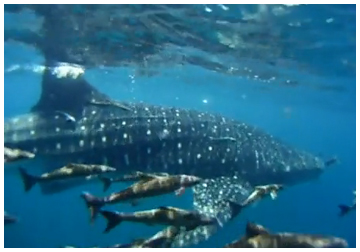
Being there
Local charter boat captain Mike Valentino, along with dive buddies James Griffith and Darcy Pentel were out on Mike’s boat August 6, and encountered a once in a lifetime experience.
While out in the Gulf fishing and diving off of Grayton Beach, Mike received a message from fellow captain Phil Hammond, who had spotted several whale sharks in the area. Mike and his friends headed over and were able to capture the graceful sharks on video.
“It was a once in a lifetime experience, both intimidating and beautiful at the same time,” Mike explained.
The five whale sharks appeared just offshore from Grayton Beach, and remained in the local waters for several days.
James Griffith captured the beautiful underwater video, Larry Pentel of Dead Fish Charters, and the others captured the still photos.
The fish swimming with the whale shark are cobia.
Local illustrator, Edmond Alexander pieced the footage and stills together to produce this beautiful video. Edmond can be contacted at: www.alexanderandturner.com
Mike Valentino can be reached at www.TriggerHappyFishing.com
Larry Pentel can be reached at www.deadfishcharters.com
About whale sharks
Habitat
In contrast to most sharks from the same order (Orectolobiformes), which are benthic (live on or near the bottom) species, the whale shark is a pelagic (open sea) species. Studies reveal that this shark prefers warm waters, with surface temperature around 21-30º C, marked by high primary productivity (much plankton). It is often seen offshore but commonly comes close inshore, sometimes entering lagoons or coral atolls.
The whale shark is thought to be highly migratory but currently there is no direct evidence to support this hypothesis. Their movements might be related to local productivity and they are often associated with schools of pelagic fish that are probably feeding on the same prey organisms.
Food Habits
Whale sharks feed on wide variety of planktonic (microscopic) and nektonic (larger free-swimming) prey, such as small crustaceans, schooling fishes, and occasionally on tuna and squids. Also, phytoplankton (microscopic plants) and macroalgae (larger plants) may form a component of the diet.
Geographical Distribution
The whale shark has a very widespread distribution, occurring in all tropical and warm temperate seas, except in the Mediterranean. It occurs throughout the Atlantic Ocean, from New York through the Caribbean to central Brazil and from Senegal to the Gulf of Guinea. It also occurs in the Indian Ocean, throughout the region, including the Red Sea and the Arabian Gulf. In the Pacific Ocean it is found from Japan to Australia, off Hawaii, and from California to Chile.
Source: Florida Museum of Natural History

kevin mike
August 22, 2009The huge, gaping mouth of a whale shark scoops up a school of small fish. All the water the shark swallows will be pushed out through the gills, while the fish will be trapped by sievelike membranes.